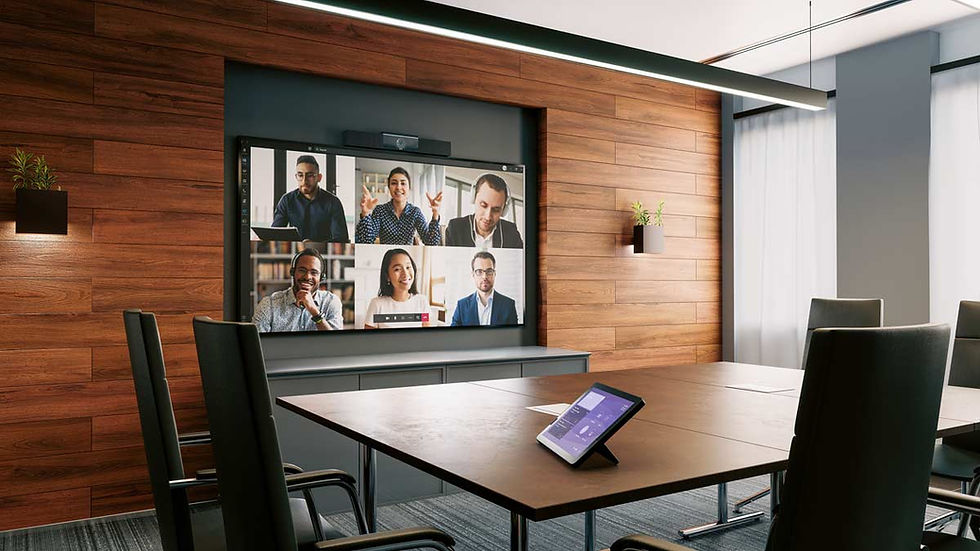Teams Rooms Setup Mistakes We See All the Time (And How to Avoid Them)
- srodriguez773
- 21 hours ago
- 3 min read
Microsoft Teams has become the collaboration backbone for many organizations, especially in government, education, and enterprise environments where security and reliable communication matter most. At E1 Audiovisual Technologies, we design and install both Microsoft Teams Rooms and Zoom Rooms, but most of our clients today are standardizing on Teams. After working in a wide range of environments, we’ve noticed several common setup mistakes that can have an impact on the overall experience.

Here are the issues we see most often—and how to avoid them.
I. Camera Installed Too High or Off to the Side
Camera placement is one of the most common mistakes in conference rooms. When the camera is mounted too high or too far to the side, remote participants feel disconnected from the room.
Why it matters:
Eye contact becomes unnatural
Remote attendees feel less included
Body language becomes harder to read
What to aim for: Mount the camera at or near eye level and centered on the main seating area. In larger rooms, consider cameras with auto-framing to maintain proper composition.
II. Microphones Too Close to HVAC or Noise Sources
Even high-end microphones struggle to overcome loud air handlers, vents, or projectors.
Why it matters:
Noise-cancelling can accidentally cut off speech
Voices sound distant or choppy
Listening fatigue increases
What to aim for: Place microphones away from noise sources and choose ceiling arrays or table mics suited to the room’s acoustics. DSP tuning can also dramatically reduce persistent background noise.

III. Displays That Are Too Small for the Room
A display that looks “big enough” on the wall may still be undersized once the room is full of people.
Why it matters:
Text becomes hard to read
Remote participants appear too small
Presentations lose clarity
What to aim for: Use recommended size-to-distance guidelines. In many rooms, dual displays work best so meeting content and remote participants each have dedicated screen space.
IV. Audio Coming from Multiple Sources
Meeting audio sometimes plays through a mix of display speakers, ceiling speakers, and sound bars without anyone realizing it.
Why it matters:
Echo and feedback
Inconsistent volume levels
Poor clarity for remote attendees
What to aim for: Simplify the audio path so all sound is routed through one unified output system. This helps eliminate echo and makes volume consistent and predictable.

V. Network Settings That Don’t Match the Room’s Needs
Teams Rooms rely heavily on stable, high-quality network connections. A restricted VLAN or limited bandwidth can quickly cause issues.
Why it matters:
Slow sign-in
Lag during screen sharing
Choppy or frozen video
What to aim for: Place the device on a network with sufficient bandwidth and the proper permissions for video collaboration. Prioritizing upstream bandwidth can significantly improve meeting performance.
VI. Mixing Non-Certified or Incompatible Hardware
It’s common to repurpose existing equipment, but Teams Rooms work best with consistent hardware ecosystems.
Why it matters:
Firmware conflicts
Devices fail to sync
Features stop working reliably
What to aim for: Use Teams-certified components or stick to a single ecosystem (Logitech, Poly, Crestron, Yealink, etc.) to ensure smooth integration.

VII. Touch Panel Installed in an Awkward Spot
Some rooms place the control panel on a far wall, behind seating, or in a corner.
Why it matters:
Meetings take longer to start
Users get frustrated
Support calls increase
What to aim for: Install the panel in a natural, easy-to-reach location, typically at the table or near the door.
VIII. Harsh or Untreated Acoustics
Glass walls, hard floors, and reflective surfaces create echo and reverberation that microphones can’t fully eliminate.
Why it matters:
Voices sound harsh or “boomy”
Remote participants struggle to understand speakers
Overall meeting quality suffers
What to aim for: Strategically placed acoustic panels, soft surfaces, or fabric elements can drastically improve clarity and reduce echo.

Why the Room Matters More Than the Software
Most Teams Rooms issues don’t come from the software—they come from the room itself. Small changes to camera placement, microphone locations, display sizing, or acoustics can completely transform how a space performs day to day.







Comments